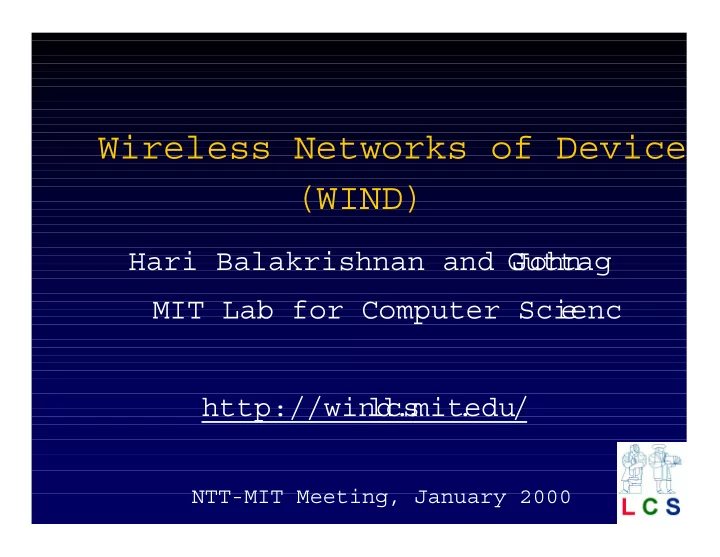

Wireless Networks of Device (WIND) Hari Balakrishnan and John Guttag MIT Lab for Computer Scienc e http://wind. lcs . mit . edu/ NTT-MIT Meeting, January 2000
Motivation Networks today Future networks Clients Audio Video Sensors Wireless Devices Mobile users Routers Web servers
Location-based wireless servi • Spontaneous networking • Automatically obtain act map of region • Communication & control • Mobility & group communication
WIND project • Configuration – Topology formation in mobile networks • Routing – Protocols for mobile device netw orks • Resource discovery – New naming system for dev ice networks • Adaptation – Congestion Manager for multimedia • Security & privacy – Private location support system
Resource discovery • Problem: advertise and locate netwo rked services • Heterogeneous environment – Wide variety of devices, services, and information • Dynamic environment – Mobile nodes and services – Variable, unpredictable performance – Device failures – Services composed of gro ups of nodes
Solution: Intentional Namin System (INS) Names are intentional; Expressiveness know what , not where Integrate name resoluti Responsiveness and message routing to handle mobility Decentralized, cooperat Robustness resolvers Easy configuration Name resolvers self- configure into overlay network
Naming and service discover • Wide-area naming (DNS) • Attribute-based systems (X.500) • Brokers (CORBA , ANSA) • Service location protocol (IETF) • Device discovery – Jini , Universal plug-and-play • Intentional Naming System (INS) – Mobility & dynamism via late binding – Decentralized, serverless operation – Easy configuration
Intentional names • Expressive name language (like XML) • Providers announce descriptive names • Clients make queries – Attribute-value matches – Wildcard matches – Ranges [vspace = lcs .mit. edu/camera] [vspace = mit . edu/thermomet er] [building = ne43 [building = ne43 [room = 510]] [floor = 5 [resolution=800x600] [room = *]] 0 F] [access = public] [temperature < 60 [status = ready] data
INS architecture Name Name resolver Name resolver Query Client Client Periodic Overlay netw ork of resolvers advertisement [building = ne-43 Service Service [room = 510]] [entity = camer a]
Name resolver functions • Name lookup • Routing protocol • Handling service mobility • Message forwarding • Self-configuration algorithm
Routing protocol tracks chan Service Service Name Name resolver Name resolver Triggered update Client Client Overlay netw ork of resolvers [building = ne-43 [room = 510]] [building = ne-43 [entity = camer a] [room = 510]] Service mobility [entity = camer a]
Late binding handles mobili Name resolver Name resolver [building = ne-43 [room = 504]] [entity = camer a] Forward to best location [building = ne-43 [room = *]] [entity = camer a] flag = ANY [building = ne-43 [room = 510]] data [entity = camer a] Intentional anycast
Intentional multicast for gr communication Name resolver Name resolver [building = ne-43 [room = 504]] [entity = camer a] Forward along spanning tree [building = ne-43 [room = *]] [entity = camer a] flag = ALL [building = ne-43 data [room = 510]] [entity = camer a]
Two notable properties • Robustness – Distributed cooperation without centralize servers – Routing information about names – Multicast forwarding • Self-configuration – Resolver network topology based on networ k performance – Decentralized spanning tree algorithm
Status • Java implementation of INS & applications – Active map, video delivery, audio jukebox, camera network (de mo) – Alpha code release for NTT • Scalability & deployment – Wide-area architecture being des igned – Standardization: MIME for devices/serv ices (XML-based)
Summary • Future networks will include heterogeneous devi & services – Configuration, routing, discovery, adaptat security • INS handles resource discove ry in dynamic, mobile networks – Expressiveness: intentional names – Responsiveness: late binding – Robustness: decentralized resolvers – Configuration: self-configuration protocol http://wind. lcs . mit . edu/
Recommend
More recommend